Types of lamp caps: standard marking and varieties of lamp caps
There are various types of lamp base caps. The lack of a single standard is due to the size and power of the lighting device, the environment in which it operates, the presence of physical impact, and many other factors. All types and cartridges and socles are well-established marking, in accordance with which you need to make a purchase.
The content of the article:
The purpose of the lamp base
The lamp base has two purposes:
- Ensuring the operation of the device. The base and the cartridge have contacts as a result of the connection of which the light source is powered from the mains.
- The ability to change the lamp in case of failure or the need to replace the device with other parameters. The base / cartridge connection should ensure the safety and ease of carrying out this operation.
Some types of lighting devices do not have a base. They are connected to the electrical circuit using flexible wiring.
Typically, this option is used for low power lamps, which are subject to physical shock or shaking. The connection “cartridge - base" in this case will be a weak point, as a result of which contact breakage will occur.
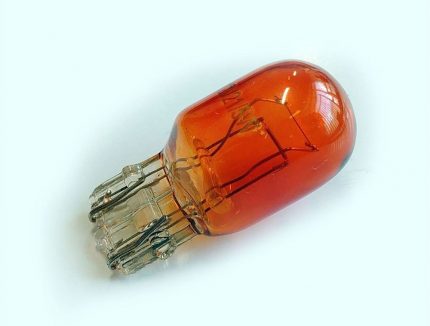
Types of connectors for lighting devices
Many countries have long implemented standards for lighting products. Now, in the period of globalization, you can buy devices from different manufacturers, including foreign ones. Therefore, the number of types of compounds is very large.
Type “E” - Edison Base
The oldest type of connection of a light source to an electric network is a standard and familiar lamp base in the form of a screw connection. The number in the marking, indicated immediately after the letter “E”, indicates the diameter of the thread in millimeters.In total, there are 10 sizes of the Edison base.
Lamps with the “E5” micro socle are often installed in foreign household appliances, appliances, and control panels.
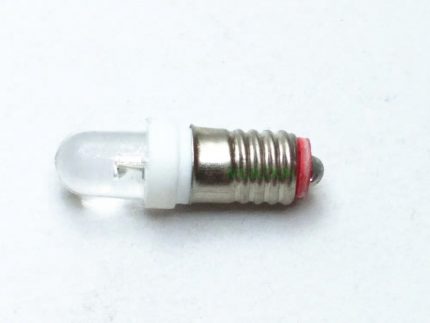
The miniature base “E10” is used when lighting refrigerators, ovens and similar equipment.
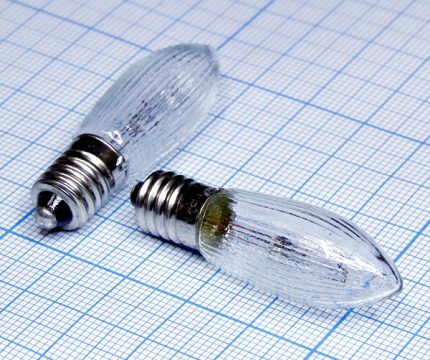
Mini-basement "E11" is often used in foreign equipment. For domestic devices use light sources with a different connection.

The “E12” format is used in the interior lighting of household appliances and in imported chandeliers.

The “E14” format is often called the “minion”. This is one of the standard socles in the territory of the former USSR.
Many chandeliers, floor lamps, sconces are equipped with lamps with cartridges for 14 mm thread.
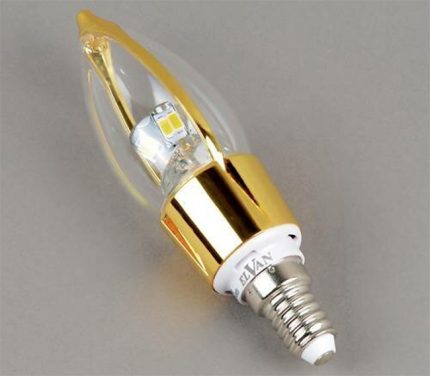
Lighting devices in the USA and Canada have three screw connection formats. One of them is “E17”.
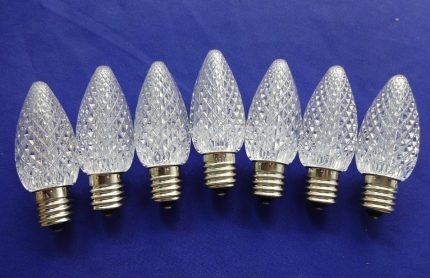
The second American format is “E26”. It is even more common than the previous one.
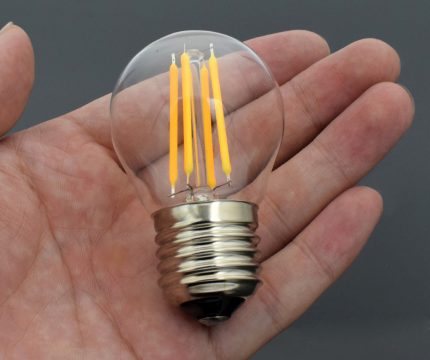
“E27” - The most popular format in Russia. You can find light sources under this base in almost any store. Due to its prevalence, it is under this standard that most lamps are produced.

Another North American “E39” format is designed for powerful light sources.
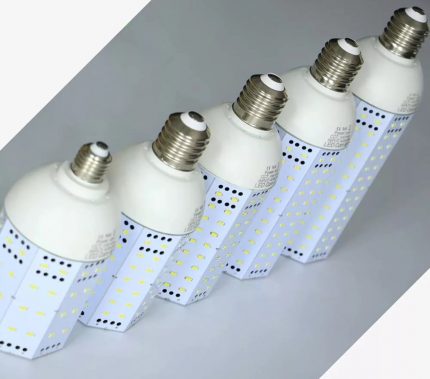
The last in this list format “E40” is standard for Russia. Under it, powerful lighting devices are made, placed, for example, on lampposts.
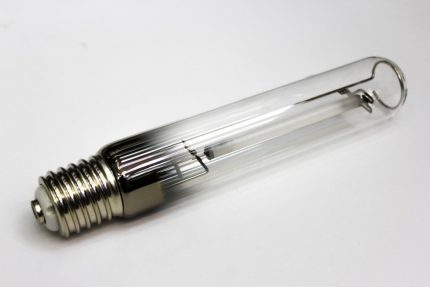
Now the proportion of lamps with Edison's base is declining. This is due to the use of more miniature and economical light sources. However, in Russia, the use of a threaded connection is still the most popular.
Type “B” - bayonet base
Bayonet (bayonet, pin) connection occurs due to insertion and rotation. It is used in many industries, including electrical engineering. The main field of application is lighting devices that operate under vibration conditions.
This mainly applies to transport. A bayonet connector is standard for electrical systems in the UK and some other countries.
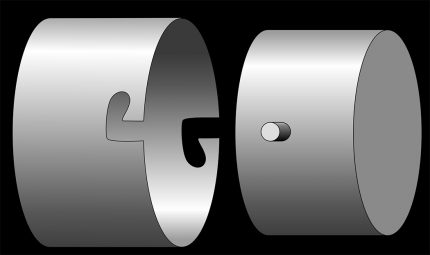
Mounts with this format are marked with the letter “B”, followed by a number indicating the diameter of the case in millimeters.
Depending on the number of contacts at the end, add another letter:
- “S” (single) - one contact;
- “D” (double) - two contacts;
- “T” (three) - three contacts;
- “Q” (quarto) - four contacts;
- “P” (penta) - five contacts.
The format of a lamp with three or more contacts is assigned to a specific industrial equipment. They are not used in everyday life.

The car version is marked with the letters “BA”. The main difference is the length of the pin. In an ordinary socle, this parameter lies in the range [0.9; 1.1] mm, while in a car the minimum length starts at 0.64 mm.
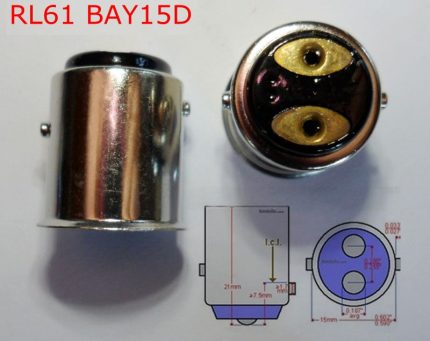
In addition to the variety associated with the number of contacts, there is another feature that complicates the search for the desired type of bayonet cap lamp lighting.
In a standard connection, both pins are located at the same level horizontally and the angle between them is 180 °. But if after “B” or “BA” there is still the letter “U”, “X”, “Y” or “Z”, then this means that the pins are offset relative to their standard position.
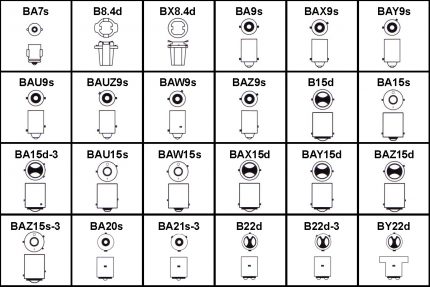
Therefore, when buying bayonet lamps (especially for cars), you need to be very careful about each letter of the cipher that describes the base.
Type “G” - two pin connector
Another popular form of connecting the lamp to the network through a cartridge is a two-pin base. It is used in compounds of LED and fluorescent lamps. This mount is marked with the letter of the Latin alphabet “G”. The numbers that follow it indicate the distance in millimeters between the pins.
Like the bayonet connection, there are modifications to the “G” format. They are indicated by adding one of the letters “U”, “X”, “Y” or “Z” in front of the numbers. In this case, there will be some differences from the base format, which can be expressed in the thickness and length of the pins, the presence of grooves and cutouts on the base.
For example, the “GU4” format has thicker pins than the “G4”, while the type “GZ4” also has longer legs. Therefore, you must carefully consider the description of the connector, as modifications are not interchangeable.
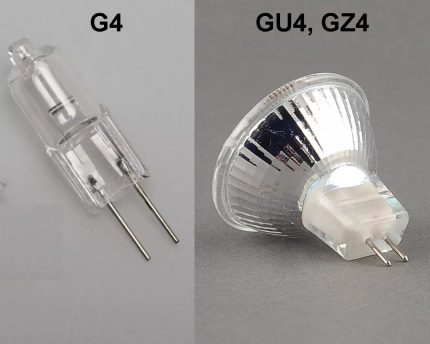
Similarly look and use light sources with mounts such as “G5.3”, “GU5.3”, “G6.35”, “GU6.35” and “G8”.
Starting with the “G9.5” cap, the pins in the form of a wire are noticeably thickened.
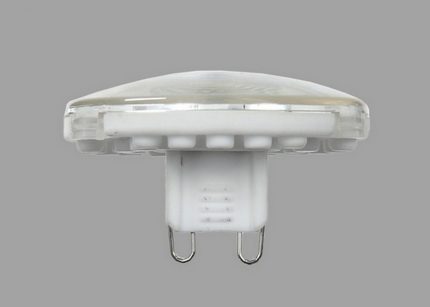
The “G9.5” format has three similar modifications with the letters “X”, “Y” and “Z”. In appearance they are almost the same.
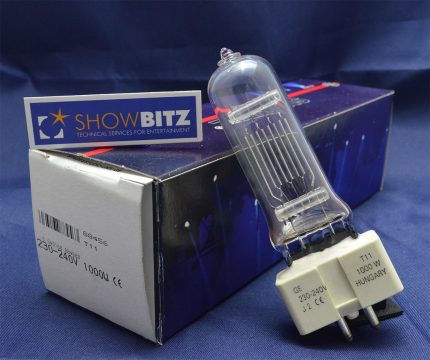
Lighting devices with the connection format “GU10” and “GZ10” are produced mainly in China.
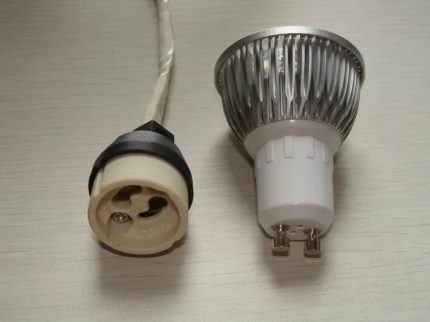
There is no “G11” format, but its paired version “2G11” exists. Also on 4 contacts are at the socles “2G7”, “2G23” and “2G27”
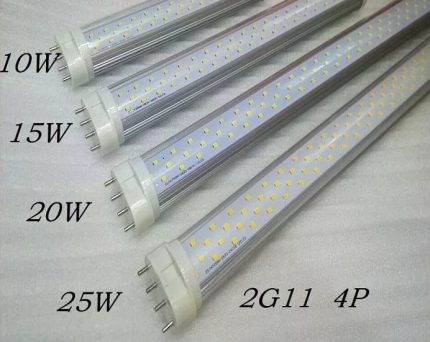
The pins on the base “G12” and “G13” have the usual even shape. On the 13th format, tubular LED lamps work.

The next two-pin connector is “G23”. It has an original appearance, very different from smaller devices.
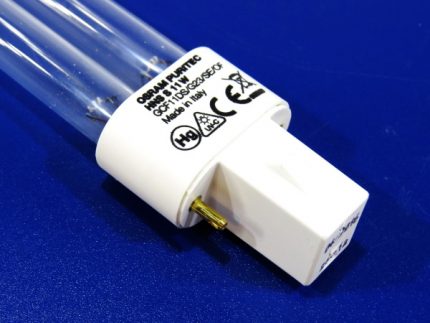
The base “G24” is used for compact fluorescent lamps, the tube of which is folded four times.
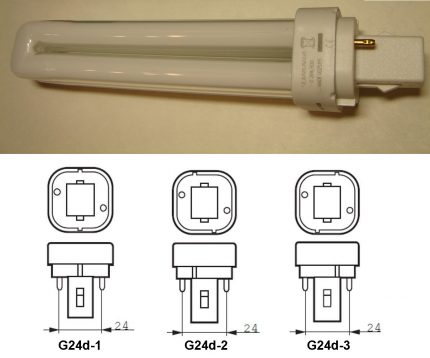
Under the “G36” and “G38” connectors there are very rare lamps for use in narrow areas. So, the model of the halogen type Sylvania FKK CP73 / CP41 under the cap “G38” is used for photo optics.
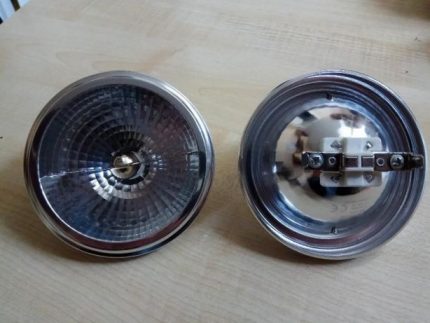
The above list of two-pin connection formats shows what kind of different socles there are for bulbs of the same type. Therefore, if the marking of the cartridge is not known, then you need to carefully measure its parameters or come along with it to the store.
Type “F” - Single Pin Connector
Some types of tubular halogen and fluorescent lamps sometimes use single-pin socles, which are located at both ends of the lighting device. This solution allows you to simultaneously pass an electric current and securely fix the lamp. A mount of this type is marked with the letter “F”.
There are 3 modifications depending on the shape of the pin:
- “A” is cylindrical;
- “B” - grooved;
- “C” is special.
The number that closes the code name of the cap means the diameter of the pin in millimeters.
Base type “Fa4” used for halogen lamps since the days of the USSR. Finding lighting fixtures and ammo for this format is easy.

The “Fa6” type connector is used by foreign manufacturers to equip fluorescent lamps. They are used where open fire is unacceptable by fire regulations.
It can be not only large, but also small-scale production. Wood or flour suspension can cause an explosion, so this source of lighting is relevant for the carpentry or flour mill.
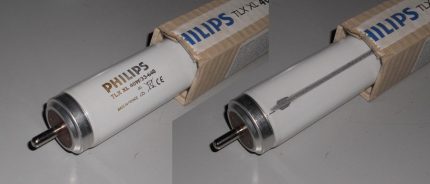
For domestic purposes, you can also use lamps with the “Fc2” format.
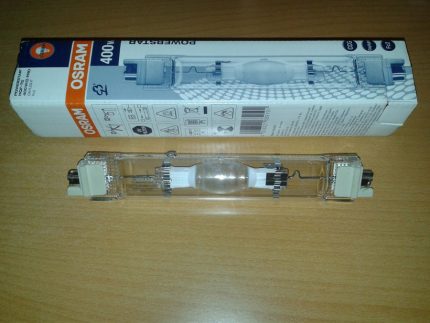
Sockets with knurled pins are now obsolete.
Type “R” - with recessed contact
This type is very similar to the “F” format, however the lamp contacts are recessed into the pin. The cartridge for such a base contains two spring-loaded metal protrusions that fix the lamp and provide electrical switching.
There are only two types of socles: “R7s” and “Rx7s”. The pin diameter for both options is 7 mm. The main difference in mounting geometry.
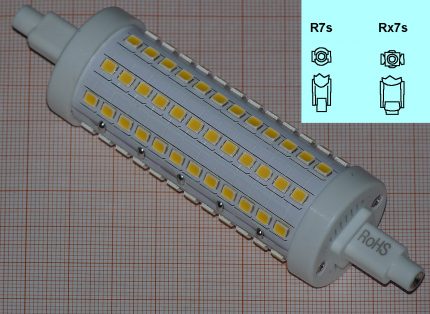
There is also a modification of “Rx7s-24”. The difference from the “Rx7s” is only in the length of the lamp - 132 mm versus 120 mm. Those. the base part is identical, and the “Rx72-24” cartridge length will be longer.
Type “S” - soffit base
The spotty type got its name because of the typical application of lamps - lighting of bathrooms and scenes, mirror lighting. It can be located on both sides for tubular lamps or in the form of a single base.
Designate this type of fastening by the letter “S”. The number following it shows the diameter of the base of the base.
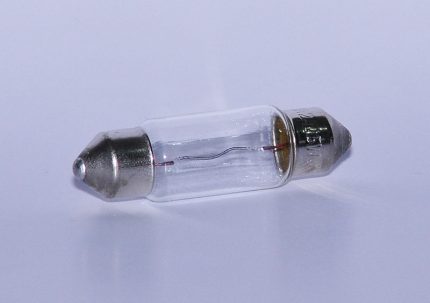
For tube lamps, the “S14” connector format is often used, for which there are two varieties. “S14s” models have two pins on the sides, and “S14d” have one pair in the middle. The shape of the base is different from the usual.
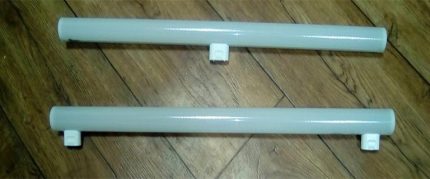
The cap shape “S19s” is a classic for spotlights.
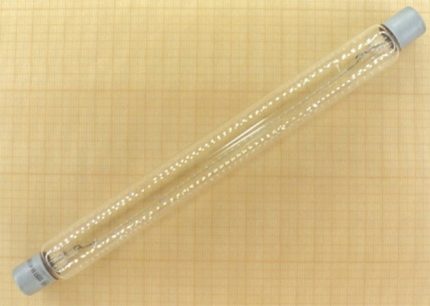
Lamps with a soffit base housing diameter exceeding 19 mm do not produce.
Type “K” - wired
Instead of the standard cartridge-base combination, a cable connection is sometimes used, which is called a wired base / plinth. It is marked with the letter “K”.

Such lamps are used to illuminate large objects. Since the conditions for installing floodlights are different everywhere, the best option for connecting such devices is the use of a wired base.
Type “H” - for xenon lamps
The car has many different light sources. For accurate placement of light bulbs use special socles marked "H". This is primarily necessary for focusing the headlights. The number following the letter means a subtype of this format.
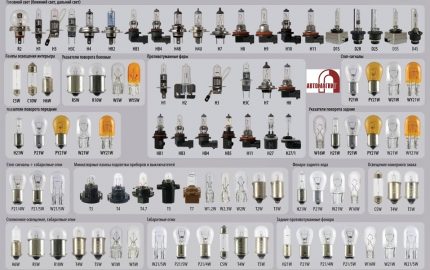
The conductive plates are made in such a way as to fix the bulb in a certain position, taking into account the vibrations and shaking that occur when the car is moving.
Type “P” - flange plinths
The flange type of the base is used when it is necessary to clearly focus the light source, therefore it is often called the “focusing" one. Lamps with such a mount are used mainly in the automotive industry.
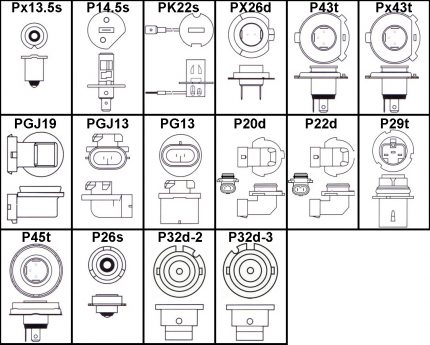
It should be noted that the shapes of the “P” type sockets are diverse and do not have any common geometric features.
Their separation into a separate type occurs only because of the property of clearly setting the light source relative to the reflector or lenses.
Type “T” - Phone Format
The telephone base is used for small bulbs that are installed in switchboards, control panels and cars. Light sources with this connection format are indicated by the letter “T” followed by a number indicating the diameter of the mount in millimeters.

The “T6.5” format has a similar appearance. But the lamps with the “T5” base, which are used in the dashboard of the car, look different.
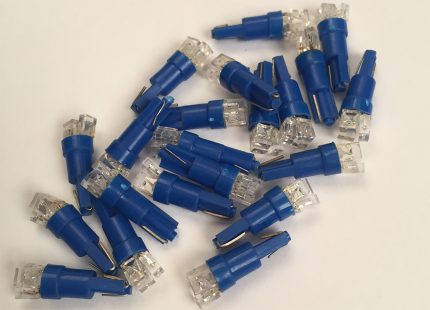
Two other formats that are often used for vehicles: “T10” and “T20”.
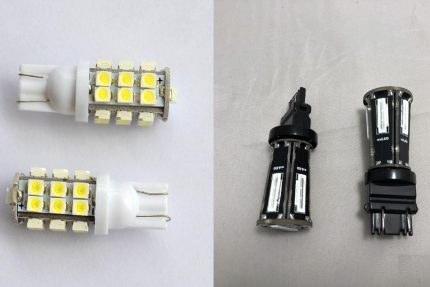
Since the LED bulbs are heated, the socles are made of heat-resistant plastic. It must withstand temperatures above 130 ° C.
Using base adapters
Sometimes situations arise when it is not possible to find a lamp with the required parameters for a specific format. For example, after buying a three-arm chandelier with “E14” lampholders, installing it and connecting lamps, it turns out that there is not enough light from it, even when using powerful LED sources, such as Lightstar T35, which produce 950 lm each.
In order not to change the chandelier, you can use special adapters from one size of the base “E” to another. Using the adapter “E14 -> E27”, it will be possible to connect lamps of the “E27” format, which can produce a more significant luminous flux. For example, the X-flash 50 model shines with a brightness of 1650 Lm.
Also on sale there are adapters from one type of cap to another. The most popular types are “E -> G” and vice versa. All these devices can be purchased in stores or ordered on well-known online sites.
Conclusions and useful video on the topic
Types of lamps for conventional screw cartridges:
It is necessary to buy a lamp in strict accordance with the marking of the cartridge. In simple cases, especially for the “E” format, you can do this yourself. But for other types, there are many modifications and nuances. In case of doubt, it is better to contact a specialist consultant.
If in the process of reading this article you have questions or have information supplementing the information presented, please write comments in the block below the text.

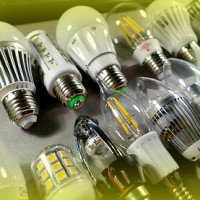 LED lamp bases: types, marking, technical parameters + how to choose the right one
LED lamp bases: types, marking, technical parameters + how to choose the right one 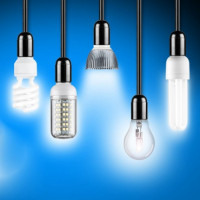 What types of bulbs exist: an overview of the main types of lamps + rules for choosing the best
What types of bulbs exist: an overview of the main types of lamps + rules for choosing the best  Mercury lamps: types, characteristics + an overview of the best models of mercury-containing lamps
Mercury lamps: types, characteristics + an overview of the best models of mercury-containing lamps 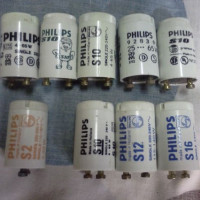 Starter for fluorescent lamps: device, principle of operation, marking + subtleties of choice
Starter for fluorescent lamps: device, principle of operation, marking + subtleties of choice  Philips LED lamp overview: types and characteristics, advantages and disadvantages + consumer reviews
Philips LED lamp overview: types and characteristics, advantages and disadvantages + consumer reviews 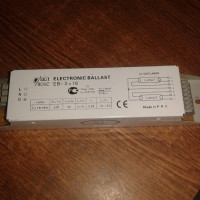 Ballast for fluorescent lamps: why is it needed, how it works, types + how to choose
Ballast for fluorescent lamps: why is it needed, how it works, types + how to choose  How much does it cost to connect gas to a private house: the price of organizing gas supply
How much does it cost to connect gas to a private house: the price of organizing gas supply  The best washing machines with dryer: model rating and customer tips
The best washing machines with dryer: model rating and customer tips  What is the color temperature of light and the nuances of choosing the temperature of the lamps to suit your needs
What is the color temperature of light and the nuances of choosing the temperature of the lamps to suit your needs  Replacement of a geyser in an apartment: replacement paperwork + basic norms and requirements
Replacement of a geyser in an apartment: replacement paperwork + basic norms and requirements
Previously used lamps with E27 base, but with us they flew in chandeliers very often. Now switched to energy-saving.
By the way, for the first time I heard that there are adapters for lamps.
Unfortunately, sometimes there are situations when the standard marking of the socles begins to "slip". In particular, this applies to the Edison pinout, which in some countries is being remade in its own way. So in the States (and in some places in Canada), our standard E27 base is usually labeled as ES, and the smaller E14 as SES. These are abbreviations for the words Edison Screw and Small Edison Screw. There are the same for other E-shek.
I also met Asian bulbs, the marking of which was not based on the type of cap, but on the outer diameter of the bulb, for example, T1 corresponds to 3 mm, T1½ - 4.5 mm, T2 - 6 mm, etc. Moreover, this is not a T base, but classic bulbs with a screw base.
Standardization is our everything! At home - only E 27, all lamps, without exception, so as not to keep a different supply in case of failure.